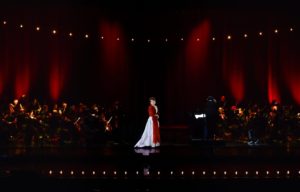What a Hologram of Maria Callas Can Teach Us About Opera
 When Maria Callas appeared onstage at the Rose Theater at Jazz at Lincoln Center on Sunday night, she looked a little pale, a little spectral.
When Maria Callas appeared onstage at the Rose Theater at Jazz at Lincoln Center on Sunday night, she looked a little pale, a little spectral.
This was understandable, perhaps: She has been dead since 1977. This Callas was a three-dimensional hologram, the latest in a series of musical-visual resurrections that have included Tupac Shakur, Michael Jackson and Ronnie James Dio. She shared the program, in fact, with Roy Orbison, who died in 1988.
Arguably the greatest singer of the 20th century, Callas — eerily, well, radiant in a white satiny gown and rich red stole — was recreated for the occasion, down to the minutest movements of her hands and the subtlest facial gestures. Her voice, in arias from Bizet’s “Carmen” and Verdi’s “Macbeth,” came from her own recordings, backed by a live orchestra at the Rose Theater. We in the audience saw only about 30 minutes of what will eventually be an evening-length concert. (The finished program, created by a division of the company Base Entertainment, begins an international tour this May in Tokyo.)
In introductory comments, Mr. Wadsworth said that the project has tried to present Callas with “restraint, subtlety and delicacy.” The notion of a singing hologram might seem incompatible with such a goal. Yet moments during Sunday’s preview were surprisingly affecting.
But what is the point of this spectacle? Who is the intended audience? Callas, a symbol of chic, remains an object of fascination extending even beyond opera fans. Perhaps the hologram will introduce some newcomers to her incredible artistry; I’d urge everyone to listen to Callas’s extensive discography.
See the full story here: https://www.nytimes.com/2018/01/15/arts/music/maria-callas-hologram-opera.html
Pages
- About Philip Lelyveld
- Mark and Addie Lelyveld Biographies
- Presentations and articles
- Tufts Alumni Bio